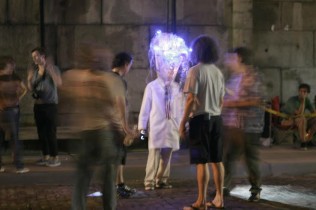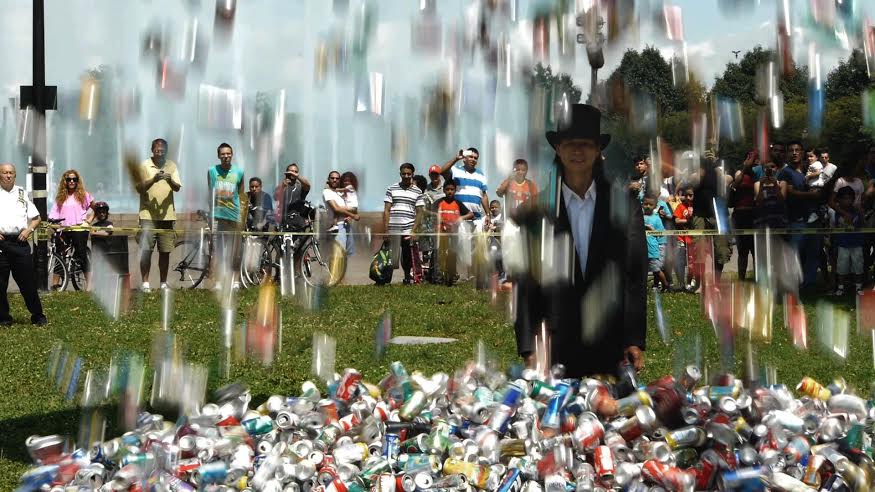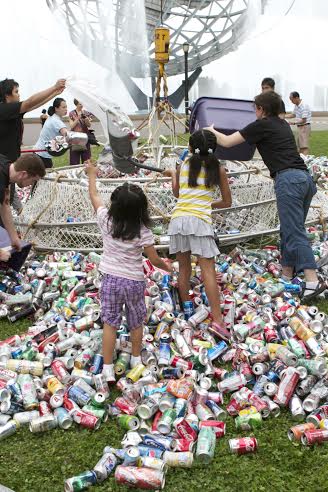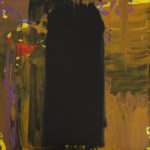The People Become the Art — An Interview with Chin Chih Yang

The art of Chin Chih Yang is nothing if not social. His projects almost function like little corporations—if by “incorporation†one understands dynamic and voluntary associations not geared toward profit. His work seems to anticipate a world where groups come together without privatization, simply to participate in a common end. The essentially interactive quality pervading his performances also shades into their message, which is generally commentary on ecology, globalism and interconnectivity. The goal of this art would seem to be the salvaging of human bonds from the restrictions imposed through spectacle and alienation, and the various technologies which service these. I recently sat down with Yang and asked after the social nature of his practice, how it involves groups, and what interaction means in light of the messages his work communicates.
Jeff Grunthaner: Your practice is highly interactive, and your projects often involve audience participation. How does this come about?
Chin Chih Yang: As an artist, I’m always looking for something that is not just interesting to me, but something which may oppose my habitual way of thinking. Involving other people and their reactions into my work is essential to how my performances will impact them. There’s a lot of experiment in this; I myself may not understand completely the projected outcome for an interactive performance. But I do have an idea regarding how something may happen: an event in real life. The possibility that something may happen is what really attracts me.
JG: Performance art sometimes approximates painting or sculpture, in that it’s still something viewers look at. Is it necessary that interactive work eschews traditional media?
CCY: If I use the traditional ways—like painting or sculpture—it doesn’t really work for me. Some artists might make something purely visual, then attach some words to explain its social significance. I totally cannot see that. If it’s able to affect the audience, if it’s involving, then a work’s message speaks for itself. It communicates. Of course, when I first started out I did something like that too. But my search has meant altering my practice step by step, from traditional media to things where…I might even say that I don’t know what I’m doing, because I don’t see all of it beforehand. But I am able to visualize how other people will involve themselves in a project.
JG: For one particular performance you recently enacted at Queens Museum—“Kill Me Or Change†(2012)—you were able to involve people into the message almost like a little pop-up corporation, but for the sake of that particular project and not for profit. Could you describe the process behind this?
CCY: It too me four years, from beginning to end, to completely realize “Kill Me Or Change,†which deals with consumerism and a global pollution threat in a very dramatic way. Every part of the project involved collaborative work with others. For example, working as an art teacher at the City Foundation in NJ, I was able to enlist students as well as their parents to bring cans to the school. The whole process was very well organized, and the kids learned how their relationship to the cans is not just a relationship to a particular thing, but to how we network and connect with different peoples globally.
JG: “Prayer for Haiti†(2010) was also a highly social project. Would you talk about the relational aspects of that work?
CCY: Normally in Union Square there’s a lot of people. But that night, because of the extreme cold— minus 7 degrees —there weren’t that many people out. Still, we had quite a lot of participants. Even when we were walking to the Haitian Consulate so many people followed us—that was really great. It’s by that level of involvement that I measure the success of a project.
JG: I was involved in “Prayer for Haiti†that night, and I remember handing out these lovely tissue-paper lanterns with LED lights inside them, and one person asking: “What’s all this about?†I said: To help Haiti. And he was like: “Haiti doesn’t need prayers; Haiti needs volunteers, etc.†How do you view the relation between your performances and social action?
CCY: When we talk to people directly, it’s better than just staying home and watching the news. Everyone looks at the media and they know what happened in Haiti. But that is not enough, because a lot of people still didn’t act; they didn’t put their hands in their pocket to donate to Haiti. People watch the news everyday; it means nothing to them. All through that kind of media – it’s not a real person. I always feel like today if someone really feels something, and talks to me face to face, then he gives me something that leads me to honest action. Affecting people is really important.
JG: With your projects, people aren’t just with you, but with each other as well. How does this relate to the messages your work conveys?
CCY: I try to clearly pass along a criticism of our society. But this message I don’t want to be so – maybe boring or maybe something like that. I don’t just want to say: Donate to Haiti or reject consumerism, like a politician. I try to communicate a message through an event. To make the message become interesting to people…so that they will say: “Hey, what’s happening here?†Maybe on other days they would just pass normally along, but today they will stop and watch for maybe another 2 or 5 minutes, and possibly get involved. That is really important: to catch people’s attention – wow them. Then they are really inside the issue. I’m sure that’s much better than if they just watch TV or read the newspaper and listen to radio. They can easily forget that.
JG: What projects are you working on now?
CCY: My main one is “Watch Me, We Can Do It!†which I will try to realize in Central Park. The project will require a lot of different kinds of people to be involved with it, and it will be much more challenging than other projects I’ve done before. I’ll need technology specialists, helicopter pilots, even a personal trainer. I may work with a rescue association, too, and hopefully larger organizations. I’d like to work with the America army. As small an artist as I am, I can still realize some higher organization in the world. This form of organization is really central to my concept. Even if the project ultimately fails—is misjudged or mocked—for me that’s not an issue. It’s a light I can hold out to people. Money is another challenge, certainly, but it will be interesting to have all those people represented and connecting on this project together.
Gallery images below–scroll right
Image 1 —
Kill Me or Chang
Interactive Performance & Installation
Queens Museum of Art, 2012
Image 2 —
Kill Me or Chang
Interactive Performance & Installation
Queens Museum of Art, 2012
Image 3 —
Human Scupture II
Interactive performance
Queens Museum of Art international 4, 2009
Image 4 —
Broken Mind
roving video projection/interactive performance
Dumbo Art Festival, 2010
Photo by Matt Taylor









4 COMMENTS
Eugene Nor
10/02/2021Thank you for this post.
Eugene Nor
08/20/2021Chin Chih goes a long way, nice story.
Pingback
12/09/2015Michael
Pingback
05/19/2015Anna B.